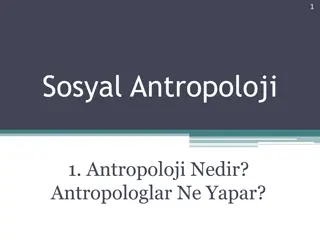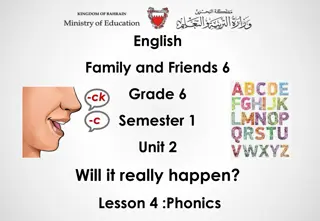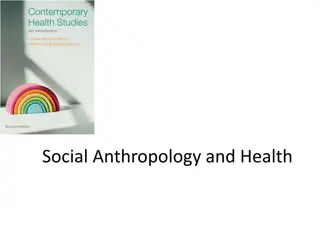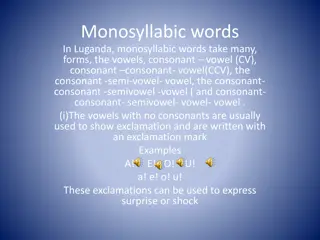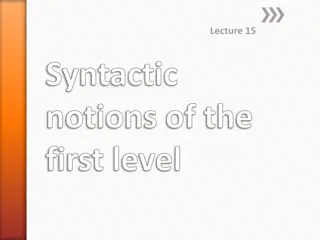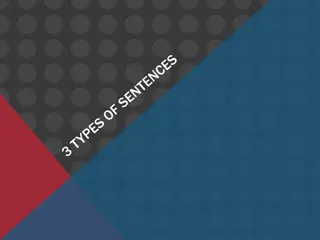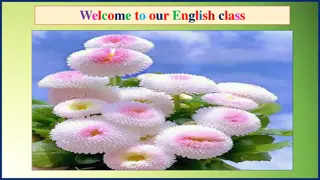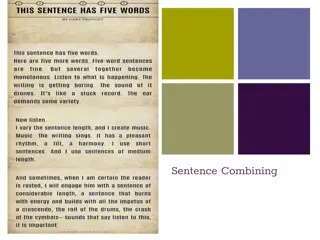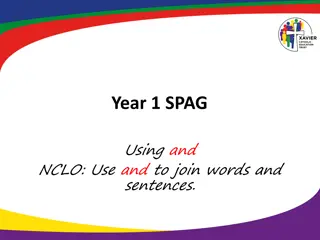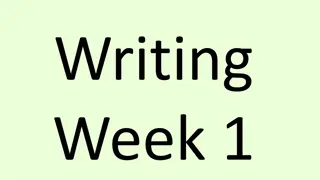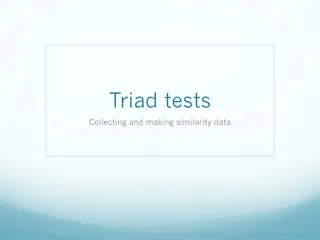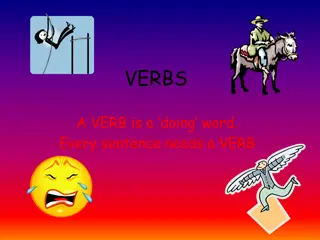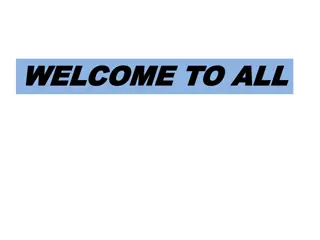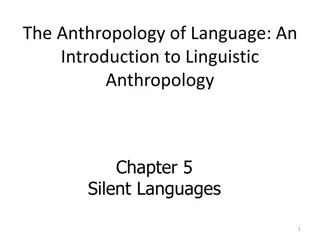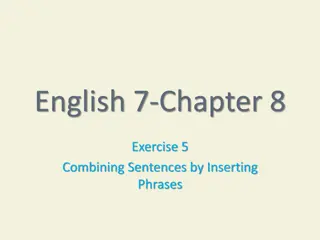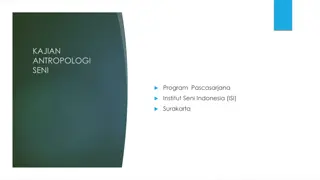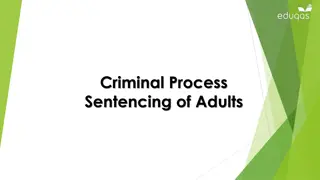The Anthropology of Language: Words and Sentences Overview
Explore the anatomy of language from morphology to syntax, delving into the structure of words, morphemes, and sentences. Understand the analysis of morphemes and their arrangements, the descriptions of bases forming words, kinds of bases like roots and stems, and creating a language from base forms to affixes. Dive into linguistic anthropology through the lens of words and sentences.
Download Presentation

Please find below an Image/Link to download the presentation.
The content on the website is provided AS IS for your information and personal use only. It may not be sold, licensed, or shared on other websites without obtaining consent from the author. Download presentation by click this link. If you encounter any issues during the download, it is possible that the publisher has removed the file from their server.
E N D
Presentation Transcript
The Anthropology of Language: An Introduction to Linguistic Anthropology Chapter 4 Words and Sentences 1
Overview From Morphology The analysis of words and how they are structured To Syntax The analysis of phrases and sentences and how they are structured 2
Morphology Words vs. morphemes Morphemes as smallest units of meaning in a language respect+ful; dis+respect+ful room+mate; stir+fry fire+fight+er Manhattan 3
Morphological Analysis Describing morphemes Analyzing their arrangements 4
Describing Morphemes: Bases Form foundations of words Establish basic meanings English: fish; talk Shinzwani: -lo- (fish); -lagu- (talk) Czech: piv- (beer) 5
Kinds of Bases Roots Serve as underlying foundation Can t be broken down any further English: fish Shinzwani: -lo- (fish) Stems Derived from roots By means of affixes(see affix slides) English: fish+ing = fishing; talk+er = talker Shinzwani: lo+a = -loa (fishing) Can have additional affixes attached English: talker+s = talkers Shinzwani: ni+ku+loa = nikuloa (I am fishing). 6
Creating a Language: Bases Please create base forms for: 9-12 things visible body parts, movable items, parts of the room 4-6 actions sit, stand, give, touch, open, close, lift, put down 2-6 persons you, me, I, we, he/she/it, you/y all, we two, we three 6-8 descriptors size, color, number 2-5 indicators/places the, a, this, that, that-over-there, in, at, on, under Anything else of interest (consider your cultural focus) Remember to use only sounds in your charts. 7
Describing Morphemes: Affixes Attach to bases Add grammatical information English: -er; -ing = fisher, fishing, talker, talking Shinzwani: hu- (to) ; niku- (I am) = huloa (to fish), hulagua (to talk) = nikuloa (I am fishing), nikulagua (I am talking) Czech: -o; -a; - = pivo (beer), piva ((2, 3, 4) beers), piv ((5+) beers). 8
Kinds of Affixes Prefixes im+possible un+likely Suffixes walk+ing Infixes fan+bloody+tastic Circumfixes m+loz+i (fisherman) Reduplication mpole+mpole (very slow) Interweaving k+i+t+aa+b (book) Portmanteau blog 9
What Affixes DO Derivation Changing one kind of word into another verbs into nouns: read -- reader; -lo- -- mlozi adjectives into verbs: modern -- modernize Inflection Showing relationships among words in a group tenses: hunted -- hunting comparisons: big -- bigger -- biggest persons: I fish -- she fishes number: cat -- cats; mpaha zimpaha (cat/cats) 10
Creating a Language: Affixes To go with your base forms, please create: an affix to derive one kind of word from another e.g., things from actions, or actions from things an affix to inflect one kind of word For example: gender: male, female, neuter... number: single, plural, dual, triple, inclusive, exclusive shape: flat, thin, round, square, oblong, 3-D, floppy... time: now, soon, never, always, yesterday, today, tomorrow validity: witnessed, heard about, heard from reliable source comparison: strong, stronger, strongest... Remember to only use sounds in your charts! 11
Analyzing Arrangement: Free and Bound Morphemes Free morphemes are like bases Can stand alone e.g., words: speak; respect; Manhattan Bound morphemes are like affixes Must be attached to other morphemes e.g., affixes: -er; -ing; dis-; -ful speak-er; speak-ing; dis-respect-ful But note: roots can also be BOUND MORPHEMES e.g., Shinzwani -lo- fish , Czech piv- beer Hierarchy among affixes English: derive first, then inflect help+er+s (not help+s+er) 12
Practice with Languages: Kanuri Workbook/Reader page 71: gana small kura big kurugu long karite excellent dibi bad n mgana n mkura n mkurugu length n mkarite n mdibi smallness bigness excellence badness /k i/ ??? sweet good ??? /n m la/ sweetness goodness 13
More Practice with Languages Workbook/Reader pp. 71-82 4.2 LuGanda 4.3 Shinzwani 4.4 Kurdish 4.5 Czech 4.6 Bontoc 4.7 Samoan 4.8 Hopi 4.9 Tepehua 4.10 Swahili Verbs (Hand in for grading) 14
Allomorphs Variant forms of a single morpheme e.g., Shinzwani (see page 90 in textbook): {singular-} /shi-/ with -ri, -sahani, -kombe /mu-/ with -hono, -ndru {plural-} /zi-/ with -ri, -sahani, -kombe /mi-/ with hono, -ndru e.g., English: cats, dogs, & horses {-plural} /-s/ following voiceless stops /-z/ following voiced stops and vowels /-Iz/ following fricatives 15
How & Why Allomorphs Change Adjusting to neighboring sounds called morphophonemic conditioning English: cats, dogs, horses; improbable, illogical Swahili: W/R 4.11 (pp. 83-84) Reflecting semantic categories called semantic conditioning Swahili: W/R 4.12 (pp. 85-86) 16
Creating a Language: Allomorphs If there s time and you feel ambitious: develop a pair of allomorphs for one of your morphemes develop a rule to explain where to use each allomorph 17
Syntax How words combine into phrases & sentences Note fuzzy boundary between morphology and syntax Shinzwani: ni+tso+hu+venza I+will+you+like All one word English: I will like you Four different words 18
Analyzing Syntax Finding and testing substitution frames Also called slots and fillers The cat in the hat The cat in the basket The cat in the tree M+paha i+send+a mji+ni the cat is going to town M+wana a+send+a mji+ni the child is going to town Gari li+send+a mji+ni the car is going to town M+tu m+zuri m+moja u+le that one good person Ki+kapu ki+zuri ki+moja ki+le that one good basket Gari zuri moja li+le that one good car 19
Labeling Substitution Frames Let the language be your guide Be prepared for different categories Grammatical gender Czech: masculine, feminine, neuter Shinzwani: human, animal, body part, useful, abstract Case Czech: subject, object, possession, location The effect of obligatory categories Grammatical categories that must be expressed 20
Ordering Substitution Frames Restrictions Which words can go together? The hat in the cat? The cat exploded on the rug? Roasting a pot of coffee? Which orders are permitted? the black cat vs. le chat noir (the) good person vs. mtu mzuri Anymore I don t eat pizza? SVO languages and prepositions? The cat in the tree vs. Mpaha mwirijuu. Let the language be your guide. 21
Ambiguities Indicate alternative substitution frames Cow kills farmer with ax (newspaper headline) Put more H2O in the coffee, then the bones (message on chalkboard in physical anthro lab) Fruit flies like a banana (attributed to Groucho Marx) 22
More examples of ambiguity Find the source of ambiguity of the following sentences. How many meanings can you find? What is it that changes? I m preparing a lecture on the internet. Kids break the ice well. Give me the report you wrote on Thursday at 5:00. 23
Using substitution frames to explore ambiguity Kids break the ice well. Kids break the ice sculpture. Kids break the ice fort. Kids break the ice well. Kids break the ice poorly. Kids break the ice easily. Try this out with the sentence Kids make great snacks. 24
Other uses of substitution frames Substitution frames are tools you can use to find relationships among group of words. Substitution frames will help you identify categories of words. Useful for understanding grammatical rules Potential window onto a different frame of reference Much of the Practice with Languages work in the Workbook/Reader involves substitution frames. 25
Kinds of Grammars Prescriptive Provides a model of proper speech Many schoolteachers, even today Descriptive Describes a language structure on its own terms Boas and anthropologists, 1900s Generative Generates all possible sentences of a language Noam Chomsky, 1950s 26
Generating Sentences Begin at the level of Deep Structure Phrase Structure Rules produce abstract sentences Transformation Rules change sentence structures Does time fly like an arrow? Phonological rules assign sounds Result is pronounceable sentence At the level of Surface Structure 27
Advantages of Generative Grammar Trees show structure more clearly. 28
Disadvantages of Generative Grammar Relies on introspection You need to know the language well enough To judge grammaticality of sentences Assumes universal underlying structure Accessible through any language But new data continues to challenge universals Not as useful in learning new languages Working with surface level sentences Requires working with actual speakers And discovery of substitution frames See KiSwahili Syntax (4.13, pp. 87-90) in W/R 29
Creating a Language: Syntax Decide on word order for your language SOV, SVO?; adjective + noun? noun + adjective? Create a simple declarative sentence type Develop a way to transform the sentence: Create negative AND interrogative expressions Create at least one tense (past, future, evidential) Insert a word Or add an affix Or change the order of words DO NOT just change intonation Create a tree to show each sentence type 30
Next: Language in Action Read: Textbook Chapter 5 Workbook/Reader: Polich (97-105) Prepare to do: Writing/Discussion Exercises (W/R pp. 107-110) Language Creating (W/R p. 119) Conversation partnering (W/R p. 120) 31



